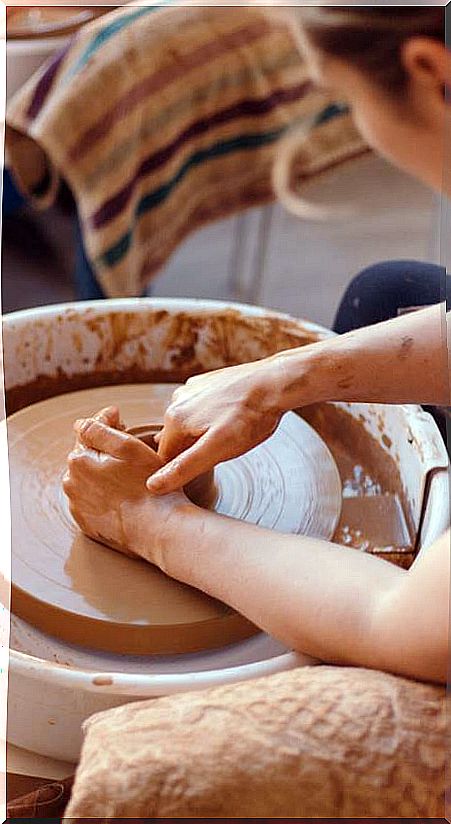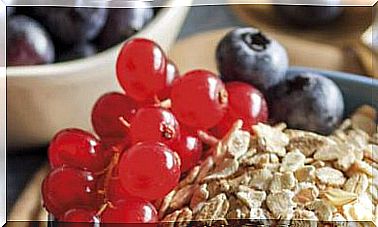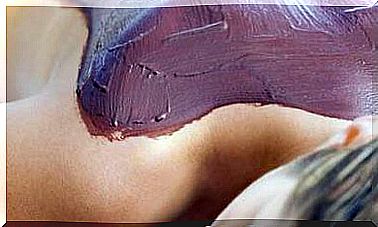Passion For Ceramics: Discover How It Links You To The Earth
Modeling clay, eating from handmade dishes or enjoying an artist’s piece unites us to the earth and our roots. Peaceful and comforting experiences that we invite you to discover.

Very little has changed the way of creating objects with clay from the artisan, who works the formless matter to turn it into beautiful and durable objects.
As in ancient times, the main tool is the hands, which begin by mixing the earth with water to make it a homogeneous and malleable material. They knead it for hours with rhythmic and repetitive movements, transmitting its strength and heat, until reaching the ideal plasticity.
Feeling its texture, its firmness and its degree of humidity allows to know the material and conceive the result from the same tactile perception.
1. Model the clay with your own hands
Many people approach ceramics only because of the hypnotic seduction exerted by the potter’s wheel. Mastering this technique requires long learning, but is enjoyed from day one. You learn to center the clay on the plate and to tune in to its sensations.
To create a vital piece that expresses and awakens sensitivity, intention – visualization – is essential. And we also have a wide range of resources: pinching is the simplest, but also emptying, churros or plates.
In the hands of fire
Ceramics are the art of the earth, but also of fire: an essential requirement for making durable objects. Long hours in the oven transform the properties of the clay and infuse it with character, with often unpredictable results.
Therefore, you must be willing to accept the unexpected, to free yourself from expectations and widen your gaze to see in the piece not only what you wanted to achieve, but also the result of the vitality of the elements.
3 recommended places to learn ceramics
Here are three proposals to experience the thrill of sinking your hands in clay and discovering the art of ceramics.
- Taller-Escola Ceràmica Ramon Fort. In his workshop in Llers (Girona), Ramon Fort has been transmitting the experience of ceramics in courses for all levels since 1988. The school has dormitories for students, who share, as in more traditional teaching, the experience of learning with a true teacher under the same roof.
- EsceramicBisbal. After 40 years of experience, the La Bisbal d’Empordà school (Girona) is currently a benchmark for ceramics in our country. A center that brings together great professionals to
teach quality ceramic art to anyone with a desire to learn. It also offers courses in other artistic disciplines with the same rigor. - Moncloa School of Ceramics. To delve into this art, the Moncloa School of Ceramics (Madrid) proposes free creation workshops, monographs and teaching for more restless spirits. Surrounded by the beautiful Parque del Oeste, it borders the Francisco Alcántara art school, with intermediate and higher cycle courses.
2. Support artisan ceramics
The handmade objects, hand designed, hand senses necessarily convey that created another sensation in series, crowded and impersonal. What is your secret? Probably, they tell a story, since they were born from the hands and the intention, and they collect the tradition of a people.
They are vital objects, which have an expression outside the circuit of mass culture, which allows us to pause for a few seconds to contemplate them. They provide a respite out of the bustle, a moment of intimacy with the land itself. The production of ceramics has a slow and patient rhythm, it does not allow haste or imposition, and that is probably what it transmits at the table: it is a call to parsimony at each meal, to give it the importance it deserves.
In the face of large-scale production, utilitarian handmade pottery has survived in our society for the love of artisans who continue to work as they did hundreds of years ago, with hardly any noticeable changes. In their workshops, they create limited series, customized if required, with which you can enjoy exclusive pieces with added value.
The craftsman’s work with clay
By its nature, clay does not allow solid pieces : it cracks or explodes in the oven. Always in concave shapes, in the design of utilitarian ceramics the center of attention is the void, the creation of a useful space that functions as a container.
Achieving harmony means integrating both elements – container and void – to create a functional container that is also beautiful, intimate and pleasant to the touch. The craftsman creates thinking about the interior space as well as the form, which he embraces and discovers.
Clay is the material, but, paradoxically, the utility is provided by the void. The poem No. 11 of the Tao-Te-Ching says: “By modeling clay, containers are made and it is their empty space that makes them useful […] and what allows a house to be inhabited.”
So forgotten for years, overshadowed by rush, technology, industry … ceramics symbolize this bond with the earth that our post-consumer society rediscovers today: living with fewer objects, although enduring, close, that gain in beauty and depth as we age, and with whom a personal connection is established. It is the most endearing aspect of austerity.
The irregularity of the handmade plates and bowls on a table is a reflection of life itself: it reminds us that, although similar, every being is different, it has its character, distancing us from cold, inexpressive perfection. And it is the bowl, this austere form, the origin of all primitive forms, that holds the most transcendent value for including emptiness and reproducing the gesture of hands together receiving food.
3 artists who work clay by hand
Currently, there are artisans who continue to work on utilitarian ceramics, although playing with new elements. We invite you to discover them:
- Lola Riviere. Simplicity can be elegant and roughness subtle. Lola Riviere is inspired by ancient cultures, in pieces with textures close to nature, marked by the passage of time, with simple and blurred shapes. His search is for the path between the soul of the everyday and its transformation into a ceramic piece.
- Ivet Bazaco. The clean line, a single color and contemporary design for small productions. Ivet Bazaco personalizes the tables of prestigious restaurants with a limited series of totally handmade pieces.
- Caterina Roma. Caterina Roma, author of this article, works with clay as words used to be. Following the Japanese tradition, she molds the clay that she herself collects in the mountains, maintaining as much as possible its original character to obtain a unique and vital means of expression. His work has one of its greatest exponents in the poetry bowls that include haikus, three-line Japanese poems.
3. Japanese porcelain and ceramics
Utilitarian by definition, Japanese pottery is a major art among the Japanese. Its intrinsic beauty is so profound that each season of the year has its own pieces: fresh white porcelain for the summer months, and thick, rough and warm pieces to keep food warm in the cold winter.
They are unique objects presented in the form of bowls, teapots, cups, jugs, chopsticks … Handcrafted, they are carefully chosen to balance and complement the colors and textures of food. There is none like it.
Japanese ceramics are based on simplicity
Rough, rough, asymmetrical … with an aesthetic conception based on nature, the ceramics of the land of the rising sun speak of changeable, incomplete, austere beauty.
Natural simplicity is one of the predominant values of the Japanese ideal and aesthetics, and because of its simple and harmonious forms, the humility of the material and the close connection with the earth, ceramics is one of the arts in which it is most expressed. strength : the most important thing is the spirit of each object, and not the qualities with which reason dresses it.
With a markedly tactile value, it is a beauty that avoids the obvious and promotes mere contemplation, awareness of the present moment in which we live and inner serenity. All in a tea bowl.
The chawan or bowl
A quintessential Japanese piece, the tea ceremony bowl can be invaluable. Often misshapen, rough and dark in color, they are works of art because they express vitality and spirituality as if they were born of nature itself.
The ceramist does not seek beauty in itself, but this is a consequence, almost an accident; Its objective is the transmission of cultural and philosophical values, which must be expressed mutely in the chawan, and which are savored with tea during the ceremony.
The tea ceremony
Japanese ceramics are closely linked to the tea ceremony, which is understood as a way to promote the contemplative state.
Katsu Kikuchi is a potter known for his Korean-style pieces designed for the tea rite. His career began in Spain and his work exudes shize (naturalness), kanso (austerity) and seiyaku (serenity), qualities of Zen Buddhism that have influenced this art.
Kintsugi: the beauty of scars
In Japan, a crack, notch or deformity in a ceramic piece can be an added value for reflection and meditation.
A broken pot does not have to be thrown away: the kintsugi restores its function and adds value. In the same way that the vicissitudes of life can positively transform a person, a piece of ceramic that does not hide the vicissitudes of time can still become more beautiful.
For this reason, in parallel with the aesthetic conception derived from the tea ceremony, an art of restoration was developed in Japan . According to this philosophy, a second life is part of the reincarnation cycle of Zen Buddhism, simultaneously transmitting a sense of rupture and continuity, fragility and resistance, death and rebirth.
3 Japanese craft projects
Understanding Japanese culture is a challenge for a Westerner. Knowing her through her craftsmanship brings us closer to her:
- Asia House. Center for the diffusion of oriental culture, with offices in Madrid and Barcelona. It offers workshops and activities on Japanese ceramics, ikebana or the tea ceremony, as well as courses on language and other aspects of their culture. An unavoidable reference for lovers of the East.
- Motoko Araki’s workshop. A small workshop hidden in the alleys of the old town of Barcelona. In it you can learn, with this Japanese artist living in Spain, traditional ceramics while transmitting her conceptual universe.
- Art-Today. The raku technique is one of the most showy and unpredictable, the result of the thermal shock of red-hot ceramic. At Arte Hoy (Madrid) they offer the possibility of a first experience with it.









